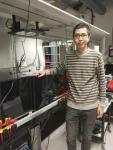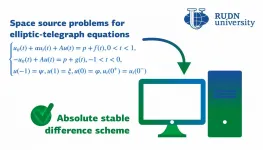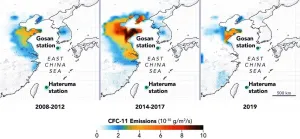Vibrating 2D materials
2021-02-11
(Press-News.org) Current electronic components in computers, mobile phones and many other devices are based on microstructured silicon carriers. However, this technology has almost reached its physical limits and the smallest possible structure sizes.
Two-dimensional (2D) materials are therefore being intensively researched. One can imagine these materials as extremely thin films consisting of only one layer of atoms. The best known is graphene, an atomically thin layer of graphite. For its discovery, Andre Geim and Konstantin Novoselov received the Nobel Prize in Physics in 2010.
While graphene consists purely of carbon, there are numerous other 2D compounds that are characterised by special optical and electronic properties. Countless potential applications of these compounds are currently being researched, for example for use in solar cells, in micro- and optoelectronics, in composite materials, catalysis, in various types of sensors and light detectors, in biomedical imaging or in the transport of drugs in the organism.
Light energy can make 2D materials vibrate
For the function of these 2D compounds, one exploits their special properties. "It is important to know how they react to excitation with light," says Professor Tobias Brixner, head of the Chair of Physical Chemistry I at Julius-Maximilians-Universität (JMU) Würzburg in Bavaria, Germany.
In principle, 2D materials are electronically excited just like ordinary silicon solar cells when sufficient light energy hits them. However, the energy can cause the atomically thin layer to vibrate at the same time. This in turn influences the optoelectronic properties.
Strength of exciton-phonon coupling is difficult to determine
Until now, it was unknown how strongly light excites such oscillations in a 2D material at room temperature. Now, in an international collaboration, a team led by Tobias Brixner has succeeded for the first time in determining the strength of the oscillation excitation upon light absorption in a 2D material - namely in a "transition metal dichalcogenide" - at room temperature.
"This quantity, known in technical jargon as exciton-phonon coupling strength, is difficult to determine because at room temperature the absorption spectrum is very much 'smeared out' and no individual spectral lines can be separated," says the JMU physicist and physical chemist.
Postdoc developed coherent 2D microscopy
Now, however, postdoctoral researcher Dr Donghai Li in Würzburg has developed the method of "coherent 2D microscopy". It combines the spatial resolution of a microscope with the femtosecond time resolution of ultra-short laser pulses and with the multi-dimensional frequency resolution. This allowed Li to quantify the influence of the oscillations.
Brixner explains: "Surprisingly, it turned out that the exciton-phonon coupling strength in the investigated material is much greater than in conventional semiconductors. This finding is helpful in the further development of 2D materials for specific applications."
INFORMATION:
The members of the international research team
Research teams led by Andrea Ferrari from the Graphene Center at Cambridge University (UK), Giancarlo Soavi from the Abbe Center of Photonics at the University of Jena and Giulio Cerullo from Politecnico di Milano (Italy) were involved in the study, which appeared in the journal Nature Communications on 11.02.2021.
[Attachments] See images for this press release:

ELSE PRESS RELEASES FROM THIS DATE:
2021-02-11
Our world needs reliable telecommunications more than ever before. However, classic devices have limitations in terms of size and cost and, especially, power consumption - which is directly related to greenhouse emissions. Graphene could change this and transform the future of broadband. Now, Graphene Flagship researchers have devised a wafer-scale fabrication technology that, thanks to predetermined graphene single-crystal templates, allows for integration into silicon wafers, enabling automation and paving the way to large scale production.
This work, published in the prestigious journal ACS Nano, is a great example of a collaboration fostered by the ...
2021-02-11
During the first confinement (18 March to 10 May 2020), people who reported worse sleep quality during a night also reported an increase in negative mood, psychotic-type like experiences and somatic complaints on the next day. Furthermore, daily reports of deaths caused by Covid-19 predicted psychological symptoms on the same day and sleep quality the following night. This is the result of research carried out in three countries (Belgium, Hungary, Spain) under direction of Peter Simor with researchers at the Université libre de Bruxelles (ULB), Rebeca Sifuentes-Ortega, Ariadna Albajara Saenz, Oumaïma Benkirane, Anke Van Roy and Philippe Peigneux from the CRCN (Center for Research in Cognition and Neurosciences) and the UNI (ULB Neurosciences Institute) ...
2021-02-11
Personality traits such as conscientiousness or sociability are patterns of experience and behavior that can change throughout our lives. Individual changes usually take place slowly as people gradually adapt to the demands of society and their environment. However, it is unclear whether certain personality traits can also be psychologically influenced in a short-term and targeted manner.
Researchers from the universities of Zurich, St. Gallen, Brandeis, Illinois, and ETH Zurich have now investigated this question using a digital intervention. In their study, around 1,500 participants were provided with a specially developed smartphone app for three months and the researchers then assessed whether and ...
2021-02-11
A mathematician from RUDN University suggested a stable difference scheme for solving inverse problems for elliptic-telegraph and differential equations that are used to describe biological, physical, and sociological processes. The results of the study were published in the Numerical Methods for Partial Differential Equations journal.
Elliptic equations are a class of differential equations in partial derivatives that are used, among other things, to model time-independent processes. Telegraph equations are presented in a nonstationary form. They were initially obtained for a telegraph communication line, but today they are also used to model the movement of insects, the flow of blood ...
2021-02-11
PHOENIX -- A Mayo Clinic team, led by Rahmi Oklu, M.D., Ph.D., a vascular and interventional radiologist at Mayo Clinic, in collaboration with Samir Mitragotri, Ph.D., of Harvard University, report the development of a new ionic liquid formulation that killed cancer cells and allowed uniform distribution of a chemotherapy drug into liver tumors and other solid tumors in the lab. This discovery could solve a problem that has long plagued drug delivery to tumors and provide new hope to patients with liver cancer awaiting a liver transplant. The preclinical study results are published in Science Translational Medicine.
Dr. Oklu, study author and director of Mayo Clinic's ...
2021-02-11
Two international studies of a consortium including more than a dozen institutions the world over, including Empa, published today in the journal Nature show levels of CFC-11 emissions, one of many chlorofluorocarbon (CFC) chemicals once widely used in refrigerators and insulating foams, are back on the decline - less than two years after their shock resurgence in the wake of suspected rogue production in eastern China was widely publicized.
"The findings are very welcome news and hopefully mark an end to a disturbing period of apparent regulatory breaches", says Luke Western from the University of Bristol, a ...
2021-02-11
Cerebral small vessel disease (SVD) is characterized by damage to the blood vessels and parenchyma in the brain. It presents as a multitude of symptoms, which makes the diagnosis difficult. Matters are complicated further when SVD sets in along with other comorbidities with similar symptoms. Therefore, accurate diagnosis at an early stage of disease progression helps in defining better prognosis and management strategies for patients with cerebral SVD.
A team of researchers from the United Kingdom set out to review more than 10,000 studies on clinical diagnosis, risk factors, progression, and intervention ...
2021-02-11
Experts have spent decades warning us about the rising rates of childhood obesity, which has become an epidemic among recent generations in many places around the world, including Spain. The transition from the traditional Mediterranean diet to the consumption of processed foods with low nutritional value is a key contributor, with child-targeted advertising also partly to blame. According to the Breakfast Food Advertisements in Mediterranean Countries: Products' Sugar Content in Adverts from 2015 to 2019 report produced by UOC Faculty of Information and Communication Sciences professor and researcher, Mireia Montaña, the majority of breakfast products ...
2021-02-11
In recent years, active, self-propelled particles have received growing interest amongst the scientific community. Examples of active particles and their systems are numerous and very diverse, ranging from bacterium films to flocks of birds or human crowds. These systems can demonstrate unusual behavior, which is challenging to understand or model.
To this end, large-scale models of active particles were being scrutinised by experts at Leicester, in order to understand basic principles underlying active particle dynamics and apply them in a scenario of an evacuation strategy for customers in crowded place. Unexpectedly, the 'super-particles' milling in a circular motion were stumbled upon ...
2021-02-11
There's a reason that ideas--even erroneous ones--catch fire on social media or in popular culture: groupthink.
New research co-authored by Berkeley Haas Asst. Prof. Douglas Guilbeault shows that large groups of people all tend to think alike, and also illustrates how easily people's opinions can be swayed by social media--even by artificial users known as bots.
In a series of experiments, published in the journal Nature Communications, Guilbeault and co-authors Damon Centola of the University of Pennsylvania and Andrea Baronchelli of City University London created an online game that asked numerous people to identify ...
LAST 30 PRESS RELEASES:
[Press-News.org] Vibrating 2D materials




